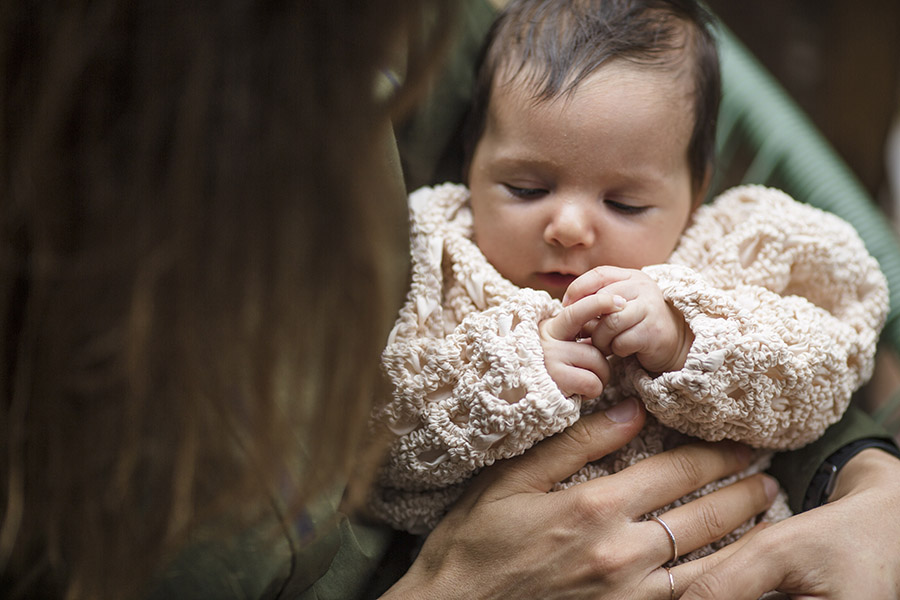Stories
Precious vision
A CERA study aims to improve screening for diabetic eye disease during pregnancy and empower women like Catherine to protect their vision.
There is nothing is more precious for Catherine than gazing at the face of her newborn daughter Netta.
Catherine has lived with type 1 diabetes since she was six and was diagnosed with diabetic eye disease in 2021.
She knew she would need to prioritise her diabetes management and eye care during pregnancy to protect her vision for the future – because some women with diabetes are at higher risk of eye complications during pregnancy.
“I spoke to my care team a year before falling pregnant to understand what I needed to do to support a healthy pregnancy,” says Catherine.
“While my diabetes control was always good, it needed to be stellar to give me the best chance of avoiding complications.”
One important change during her pregnancy was more frequent eye screening – from every two years to every three months – to make sure any changes were caught early.
“I think of protecting my health, including my eye health, as self-care,” she says.
“The incentive to be in good health to see my daughter grow up feels like the biggest reward imaginable.”
People with diabetes can have abnormally high blood sugar levels, which damage the small blood vessels in the retina and cause an eye condition called diabetic retinopathy.
Diabetic retinopathy can cause vision loss, most commonly from diabetic macular oedema that affects our ability to recognise faces.
Regular eye checks can catch diabetic retinopathy early, which offers the best chance of preserving sight.
“For women with diabetes, eye screening during pregnancy is particularly important because risk factors for diabetic retinopathy like high blood pressure and high blood sugar levels are even harder to control during pregnancy,” says Associate Professor Lyndell Lim, Head of Clinical Trials Research at CERA.

New data
A lot has changed about the way we understand and treat diabetes in the three decades since Catherine was diagnosed.
“In the early days, my parents helped me manage my condition by injecting insulin multiple times a day,” she says.
“Fast forward 30 years, and I now use an insulin pump with continuous glucose monitoring, together with my gorgeous assistance dog, Beadie, who is trained to detect hypoglycaemia.”
The demographics of pregnant women with diabetes has also changed in this time – from mostly women with type 1 diabetes, to an increasing number with type 2.
It was this shift that prompted Associate Professor Lim to investigate the prevalence of diabetic retinopathy in pregnant women in 2022 and update the Australian data that was over 40 years old.
“We set out to see whether diabetic retinopathy in pregnancy still takes off in modern times when there’s better treatment, control and screening, and also how it affects a different diabetes population, where 50 per cent have type 2 diabetes,” says Associate Professor Lim.
Diabetic retinopathy risk
The study found that about one in four pregnant women with diabetes had diabetic retinopathy.
Nearly one in nine participants had a sight-threatening form of the disease, which persisted for a year postpartum.
“Our research shows that in 2022, there is still a significant proportion of Australian women who have or develop diabetic retinopathy during pregnancy, and for some women this could lead to devastating vision loss,” says Associate Professor Lim.
“Importantly, we also found diabetic retinopathy in women with type 2 diabetes. And the disease progressed in some of these participants. There has been no other Australasian research that’s shown this.
“These findings indicate that we need to keep getting the message out to women with diabetes that it’s crucial to be screened for diabetic retinopathy during pregnancy, regardless of whether they have type 1 or type 2.
“However, we also saw that more than one in 10 women were unable to come in for an eye check as part of our research.
“There are clearly barriers to screening we need to address, and this will be the focus of upcoming research.”
The future of diabetes eye care
In a follow-up paper, to be published in 2023, Associate Professor Lim has shown that the risk of developing diabetic retinopathy in pregnancy is different for women with type 1 versus type 2 diabetes.
This could change how we screen for diabetic retinopathy in future, as the current clinical guidelines do not differentiate between type of diabetes.
Regular eye screening during pregnancy has preserved Catherine’s vision, and she is grateful for the future impact Associate Professor Lim’s research could have on the pre-natal care of women with diabetes.
With improved screening and early treatment, there is hope that new mothers with diabetes will not have to face losing their sight from diabetic retinopathy in future.
As Catherine puts it: “A parent not being able to see their child when they are born or as they grow is heartbreaking.
“It’s amazing to think that research at CERA could bring us closer to a world where that is less likely to happen.”
This story was originally published in See the future: Annual Review 2022.
